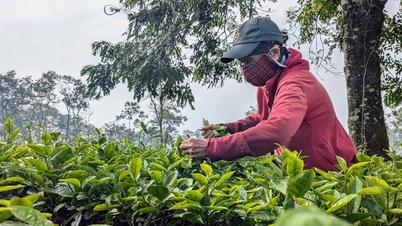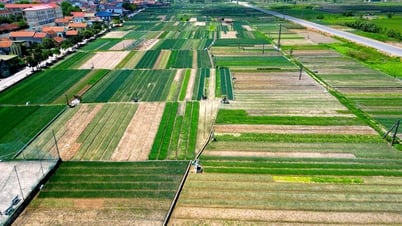For the first time in the history of the industry, coffee prices have surpassed the $5,000/ton mark and domestic coffee has exceeded VND100,000/kg as the new harvest season approaches. However, Vietnam's coffee output in the 2024-2025 crop year is estimated to reach only about 1.5 million tons, down about 10% compared to the previous crop, according to the Vietnam Coffee and Cocoa Association (Vicofa).
Coffee price today 9/19/2024
World coffee prices fluctuated, Arabica reversed, while Robusta on the London floor continued to rise to a new record.
Domestic coffee prices today, September 19, are trading in the range of 123,300 - 123,800 VND/kg.
Coffee prices had a volatile session on the day the US Federal Reserve (Fed) decided to cut interest rates by 0.5%. According to experts, the market was a bit surprised when the Fed's interest rate cut this time was considered gentle, not too "hawkish". Coffee prices did not increase too much, ending the session with a slight increase, not a gallop like every time US bank interest rates increase/decrease.
In addition, overbought pressure is still present on both exchanges, and the market is already preparing for the Fed's interest rate cut. The impact of the interest rate cut is not yet evident, but will help coffee have good momentum until the end of the year.
Arabica markets were under slight pressure on Wednesday after Rabobank forecast global coffee production in 2024/25 to rise 2.2% year-on-year to 174 million bags, leaving the world with a small surplus of arabica beans. However, the decline was quickly limited as meteorologist Climatempo reiterated its forecast for continued hot and dry weather in Brazil’s coffee-producing regions through the weekend.
Domestically, trading has been quiet due to limited supplies. Market concerns remain over the ongoing weather issues affecting the upcoming crop in Vietnam, from October 2024, with forecasts of El Niño weather patterns likely to reduce yields.
 |
| Domestic coffee prices on September 18 were slightly adjusted by VND200/kg in some key purchasing localities. |
According to World & Vietnam , at the end of the trading session on September 18, the price of robusta coffee on the ICE Futures Europe London continued to increase, the delivery period in November 2024 increased by 31 USD, trading at 5,334 USD/ton. The delivery period in January 2025 increased by 30 USD, trading at 5,070 USD/ton. The average trading volume was low.
Arabica coffee prices on the ICE Futures US New York exchange turned down, with the December 2024 delivery period down 0.10 cents, trading at 264.40 cents/lb. Meanwhile, the March 2025 delivery period down 0.50 cents, trading at 262.30 cents/lb. Average trading volume is high.
Domestic coffee prices on September 18 were slightly adjusted, increasing by VND200/kg in some key purchasing localities. Unit: VND/kg
(Source: giacaphe.com) |
According to the Vietnam Coffee and Cocoa Association (Vicofa), for the first time in the history of the industry, coffee prices have surpassed the $5,000/ton mark and domestic coffee has exceeded VND100,000/kg as the new harvest season approaches. However, Vietnam's coffee output in the 2024-2025 crop year is estimated to reach only about 1.5 million tons, down about 10% compared to the previous crop.
At current prices, coffee growers will benefit and coffee trees can continue to compete with other high- value crops such as durian and pepper.
In the long term, coffee prices may continue to remain high due to the impact of climate change, which reduces global coffee supply. On the contrary, the demand for coffee consumption in the world is increasing, even in countries with no tradition of using coffee in Asia.
Market focus continues to be on weather conditions and the new 2024-2025 harvest in Vietnam. However, there is a high possibility that Vietnam’s robusta output will continue to fall short of its potential due to the impact of the El Niño weather phenomenon.
Meanwhile, according to the US National Weather Service, there is a 71% chance of La Niña appearing by the end of 2024, lasting from January to March 2025. The impact of this weather phenomenon is still uncertain and could bring the opposite weather conditions to El Niño. Brazil’s arabica coffee growing region remains dry, with light rains forecast for the end of the month. Large areas such as Minas Gerais, Espírito Santo, Rio de Janeiro, and Sao Paulo recorded low soil moisture, 35.98% below the five-year average. This could affect the country’s upcoming 2025-2026 coffee crop.
In terms of global supply, next year’s production forecasts are subject to change as the El Niño weather phenomenon has largely affected this year’s crop. The good news is that Colombia’s output is recovering, with an estimated 12.8 million bags. The country can supplement domestic production by importing green coffee from Brazil and Peru. Domestic consumption is forecast to increase by 1.6% to an estimated 2.3 million bags.
Central America and Mexico coffee production is forecast to increase by 6.4% from the record low of 2023-24, with output estimated at 16.5 million bags in 2024-25. Honduras, Nicaragua, and Costa Rica are expected to contribute to the recovery, although output will still be 12.5% lower than previous years.
Higher robusta prices are expected to encourage producers in West and East Africa, with Uganda leading robusta production in Africa, with output expected to remain stable at 15 million bags. Ethiopia, which produces only arabica, is expected to reach 7.5 million bags, with about half consumed domestically.
Source: https://baoquocte.vn/gia-ca-phe-hom-nay-1992024-gia-ca-phe-robusta-tiep-tuc-lap-dinh-fed-khong-qua-dieu-hau-cay-ca-phe-viet-nam-co-the-tiep-tuc-canh-tranh-286827.html



![[Photo] Anh Hoang - Dinh Duc successfully defended the men's doubles championship of the National Table Tennis Championship of Nhan Dan Newspaper](https://vphoto.vietnam.vn/thumb/1200x675/vietnam/resource/IMAGE/2025/5/23/d6ab3bcac02c49928b38c729d795cac6)

![[Photo] Top players gather at the 2025 Nhan Dan Newspaper National Table Tennis Championship](https://vphoto.vietnam.vn/thumb/1200x675/vietnam/resource/IMAGE/2025/5/23/9ad5f6f4faf146b08335e5c446edb107)





























































































Comment (0)